Placer
What do these photos tell you about how early gold miners did their work?
Placer Miner Panning Gold
The man in this photo is using a pan to find gold in a stream.
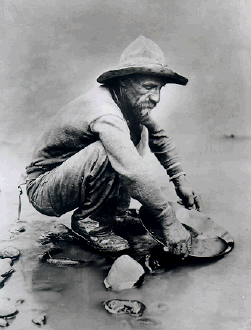
Photo: Colorado Historical Society
More About This Topic
The first miners in Colorado looked for "free gold." These were flakes of gold lying in stream beds. It could be recovered by swirling water around in a pan full of sand and gravel taken from a stream. As the sand and gravel were washed out, the heavier gold settled to the bottom of the pan. Washing gold out of stream beds and the banks of creeks was called placer mining.
Their Own Words
"Our medium of exchange in those days was mostly gold dust, carried in a buckskin sack and weighed out on gold scales. The smallest amount that was ever weighed out was 25 cents worth."
"That gathers all the Gold from among the Sand. Then we have to retort [heat] the Gold in order to Separate it from the quicksilver which takes from 10 to 12 o'clock every night. No small job rest assured. . . ."
Source: Recollections of S. M. Buzzard, Colorado Springs Telegraph, July 31, 1921.
Source: "The Letters of David F. Spain," (letter to wife, April 30, 1859), in John D. Morrison, Colorado Magazine 35 (April 1958): 105-106.
Placer Miners At Work
This photo shows two men mining for gold using a shovel and pan.
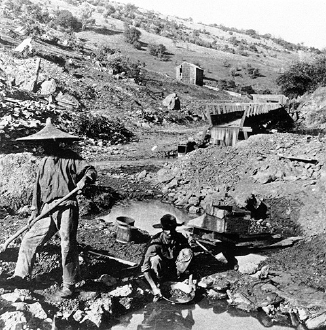
Photo: Colorado Historical Society
More About This Topic
Tiny bits of gold also settled in the dirt along the banks of creeks. Miners recovered this gold by shoveling the dirt into pans and washing it with water from the creek. This kind of placer mining worked best with two men. One man shoveled while the other used the pan, like the men in the photo.
Their Own Words
". . . I'll tell you what we have done in the last week in the way of mining. Have taken out since one week ago today Ten hundred and ninety (1091) Dollars. . . . We have crowds of New Comers around us from morning till night watching, and wishing it were them. . . . We have sold one of our Claims to George Simmons (the Chicago man) for Three Thousand five hundred Dollars to be paid as fast as he takes it out. And on Saturday last we sold half of the claim we are now working for Five Thousand two hundred and fifty Dollars. That also to be paid as fast as taken out."
Source: "The Letters of David F. Spain," (letter to wife, April 30, 1859), in John D. Morrison, Colorado Magazine 35 (April 1958): 105-106.
Drawing Of Gregory's Diggings
The men in this drawing are at Gregory's Diggings near present-day Central City. They are looking for gold with various tools used in placer mining.
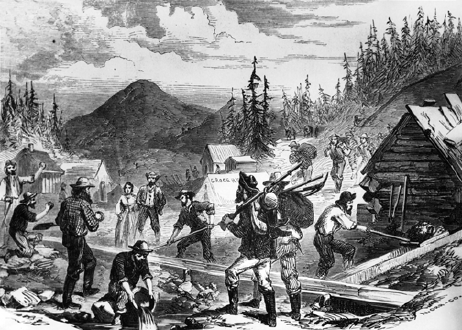
Photo: Colorado Historical Society
More About This Topic
Placer miners also used sluice boxes or "long toms" to take gold from the streams. Sluice boxes were long, wooden troughs with slats nailed to the bottom. Miners shoveled dirt into the box as water ran through it. The water carried the dirt away, leaving the heavier flakes of gold to settle to the bottom, where it was caught in the slats. The miners periodically stopped the flow of water and removed the gold from the slats. This was done every few days or weeks in small sluice boxes. In some large sluices that extended for a mile or more, the "cleanup" was done only a few times each year.
Their Own Words
"Work usually started at the placer mines about the first of April and ended during the latter part of September or early part of October, depending on the water and weather conditions. The old system of placer mining was employed. The flume, or sluice box, was about two miles in length and about two feet in width; the riffles were made of poles, originally five inches in diameter, but they were worn down rapidly. Excepting a small amount of 'light' gold, the first half mile of flume usually caught it all."
"The 'cleanup' was made but twice a year. First the riffles were washed, to save the gold clinging to them, and removed from the flume. Then a small stream of water was turned in to wash away the dirt and all black sand possible. The water was then reduced to a mere trickle and quicksilver poured into the flume and gradually worked to the lower end. One hundred and twenty-five pounds of quicksilver was required for the cleanup which usually netted about 50 pounds of course, 'shot' gold."
Source: Joe F. Maro [as told to Richard Carrol], "Reminiscences of the Granite Mining District," Colorado Magazine, 13 (July 1936): 137-138.
Source: Joe Maro, quoted in Richard Carrol, "Reminiscences of the Granite Mining District," Colorado Magazine 13 (July 1936): 138-139.
Placer Miners Near Central City
This photo shows men using shovels and a sluice box to mine for gold. The photo was taken in 1877 at Russell Gulch near Central City.
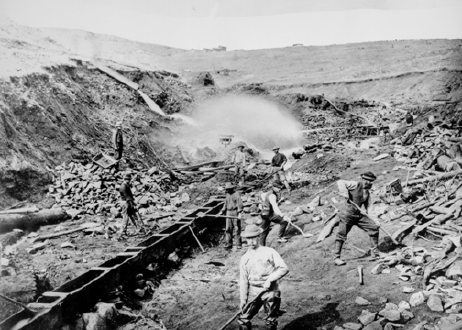
Photo: Denver Public Library, Western History Collection
More About This Topic
The amount of dirt that could be washed in a sluice box depended on the number of men operating it. The photo shows at least seven men working at this sluice box. Longer sluice boxes had even larger work crews.
Their Own Words
"We have found this gold in nearly every place we have prospected from the mouth of the canyon, for a distance of twenty-five miles in a north-westerly direction, and I know, by actual experiment, that a man can make with a rocker $5 per day."
Source: A. A. Brookfield to Friend Norton, Gold Hill, March 5, 1859; Phyllis Smith, A Look at Boulder From Settlement to City (Boulder, 1981): 14.
Placer Miners Using a Sluice
The miners in this photo are shoveling dirt into a sluice.
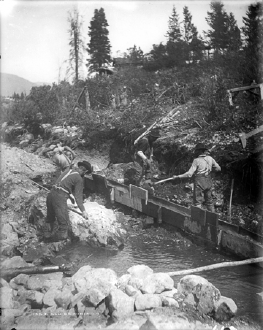
Photo: Denver Public Library, Western History Collection
More About This Topic
The men in this photo are using a long sluice box built in the middle of a stream. They are washing out the dirt from the banks of the stream, leaving only bare rocks and boulders behind. Mining changed the landscape of the Colorado mountains.
Their Own Words
"Agriculture restores and beautifies, mining destroys and devastates, turning the earth inside out, making it hideous, and blighting every green thing…. There was mining everywhere along that grand road, with all its destruction and devastation, its digging, burrowing, gulching, and sluicing."
Source: Isabella Bird, A Lady’s Life in the Rocky Mountains (London, 1879): 224.

